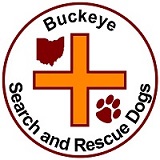
As stated in the “Scent” page on our site, every person has a unique scent, to the exclusion of all other people, and this scent is deposited constantly as we go about our daily routines. It also is carried by our body heat up into the air currents that are constantly present in the environment and are blown about.
The area K9/handler search team takes advantage of this fact to find the scent floating in the air and follow it to the strongest source, which hopefully is the location of the missing person. This technique is also often called “air-scenting.”
The handler will attempt to find an area on the downwind side of the area to be searched, which will have been based on the investigation to this point.
The handler will decide upon a strategy to try to locate a scent cone. Depending on the weather conditions, the cone can be relatively small and concentrated, or very large but more diffuse.
Every handler has their preferred method, which can include techniques like working a grid, working in from the perimeter, segmenting the area into smaller pieces, or quartering across the wind. They will adapt their strategy based upon the terrain conditions and the weather at the time of the search.
Starting an Area
Unless there is some hazard to working off-lead, like along a busy highway or in an area with steep drops, most handlers will prepare their dog for the search by removing the leash, allowing the dog to freely range through the area.
Some handlers will then allow the dog a moment or two to sniff around nearby to let the dog develop an overall “scent picture” of the immediate area.
If the dog is trained to be scent-specific, the handler will present the scent article to the dog. If the dog is not scent-specific, no scent article is used, because the dog will seek the scent of any human in the search area.
Once the dog is ready, the handler will signal to the dog that it’s time to work by giving them their search command and directing them into the search area.
Working The Scent Cone
Area search dogs carry their noses up most of the time, occasionally stopping to pick up scent from the ground, the surrounding vegetation, the wall of a building, or anywhere else the scent can collect.
As an example, lets assume there’s a light breeze and the handler has decided to work across the wind. They may start the K9 at a location just outside and downwind of the search area. Then they give the dog the search command and direct them across the wind, watching for any changes in body language that indicates the dog is picking up the desired scent. Getting to the end of that pass, the handler moves the dog maybe 30 feet upwind, then passes across the wind again while watching the dog’s body language.
The handler repeats the pass, move a little upwind, pass again, back and forth until the dog has either indicated there is no scent in the area or has indicated they have found an edge of the scent cone.
Once the scent cone is discovered, usually the K9 will continue to move back and forth in ever narrower passes, gradually working upwind.
Tip of the Cone
As the dog gets closer to the missing person, they may do much less side-to-side ranging and focus more upwind. Often the dog will also pick up speed as they home in on the subject.,
When the dog arrives at the missing person, they will identify the subject by performing a “Trained Final Response.” This is a behavior that has been reinforced throughout the dog’s training to indicate to the handler that this is the person they have been seeking. The location will be marked and the information will be relayed back to the Incident Command Post so the missing person can be safely recovered.
On the other hand, maybe the missing person is not there. This can mean the person was here for a significant time, but then left the location. If this happens, the dog will let the handler know through their body language that there is nothing to follow beyond this point. The location will be marked and the information will be relayed back to the Incident Command Post as a clue to be investigated further.
Additional area searches may be attempted and the search will continue until the missing person is located and recovered or the search is suspended until further investigation can provide additional clues with which to work .
